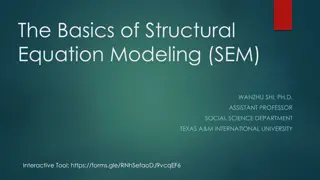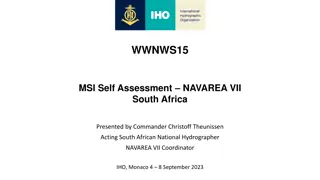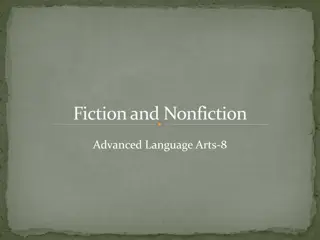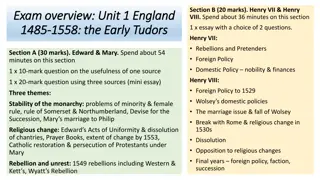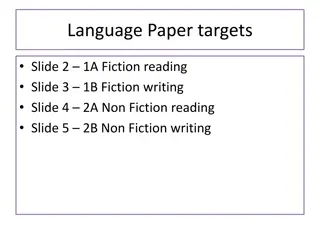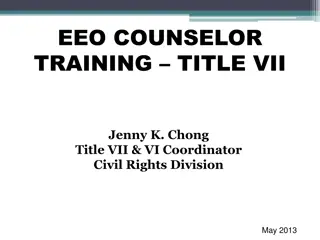
A Passage to India by E.M. Forster: Summary & Analysis
Explore E.M. Forster's novel "A Passage to India," depicting the complexities of British-occupied India and the relationships between English and Indian characters. Dive into the setting of Chandrapore, the Marabar Caves, and the cultural clashes portrayed throughout the three parts of the book. Unravel the themes of friendship, obstacles, and reconciliation as Forster delves into the intricate dynamics of colonial India.
Uploaded on | 0 Views
Download Presentation

Please find below an Image/Link to download the presentation.
The content on the website is provided AS IS for your information and personal use only. It may not be sold, licensed, or shared on other websites without obtaining consent from the author. If you encounter any issues during the download, it is possible that the publisher has removed the file from their server.
You are allowed to download the files provided on this website for personal or commercial use, subject to the condition that they are used lawfully. All files are the property of their respective owners.
The content on the website is provided AS IS for your information and personal use only. It may not be sold, licensed, or shared on other websites without obtaining consent from the author.
E N D
Presentation Transcript
A PASSAGE TO INDIA E M FORSTER MA II SEM PAPER VII DEPARTMENT OF ENGLISH GOVT COLLEGE PAONTA SAHIB
1. Introduction E.M. Forster published his novel A Passage to India in 1924, after he visited India beforehand in 1912 and in 1921. The novel deals in large parts with the political occupation of India by the British army and the concluding relations between the English and the native population. It is also about the friendship between the two main characters, Cyril Fielding and Dr. Aziz, with all its obstacles.
2. Location The novel's setting is the fictive city of Chandrapore, a small Indian city on the Ganges and near the Marabar Caves. Chandrapore is based on Bankipore, one of the cities which Forster visited in India (cf. Forster 338). The city of Chandrapore is predominantly Moslem, and its unique attraction is the Marabar Caves, which is a short train ride away from the city. The caves of the book are based on the real Barabar Caves (cf. Forster 347). Forster put them near Chandrapore, so that they were visible from his fictive city, aiding the atmosphere and to simplify the travel to the Caves.
3. The Three Parts of A Passage to India 3.1 Mosque A Passage to India consists of three parts. Each part centres on a particular setting or location. Mosque , the first part, takes place in Chandrapore, which is at the time of the novel occupied by both the British and the native Indians. During this part the central problem is explained and set up: The city itself and therefore India is described like a muddle and there is a huge gap between the Indian people and the English occupants.
3.2 Caves The second part is entitled Caves . It centres on the Marabar Caves, the site of Adela's dramatic experience and the trial against Aziz. In the caves Mrs. Moore panics because of the echo; she is haunted by it until her death. Adela is also confused by the echo; she loses her sense of reality and imagines that Aziz insults her. He is then accused of raping her. This ruins his life in Chandrapore and his future, leading him to move away. The accusations destroy the friendly relationships that were beginning to build up before. This chapter shows that hostility, evil and negation triumph. There is frustration and alienation between the cultures. Adela realizes her mistake during the trial through the echo of the people chanting Esmiss Esmoo
3.3 Temple The third part is set among the Hindu people in Mau during a religious festival, two years after the other parts, emphasizing again the contrast between the cultures. The Temple is the symbol of the Hindu religion: it stands for reconciliation, regeneration and hope. The celebration of the Birth of Shri Krishna in the first chapter of the part stands for the belief that all sorrow is annihilated and that infinite love prevails. This attitude reflects through the whole third section of the novel
The book is an interpretation of India, traditionally a land of mysteries and muddle, and an interpretation of its impact on those who live in it and on the aliens who come to it. On the historical level, the novel traces the passage undertaken by two sympathetic British ladies to see the real India , to bridge the gap between the East and the West. Separation of race, sex, and culture religion exist and disturb mutual unity and understanding of humans. Yet, ultimately, human, racial, cultural, religious, political relations can be improved by giving up prejudice, arrogance, pride, and feelings of superiority or inferiority.
That seems to be the final message and central forces of the novelist in A Passage to India. The novel is, indeed, more than a passage to India a spiritual search of one s self and beyond.






